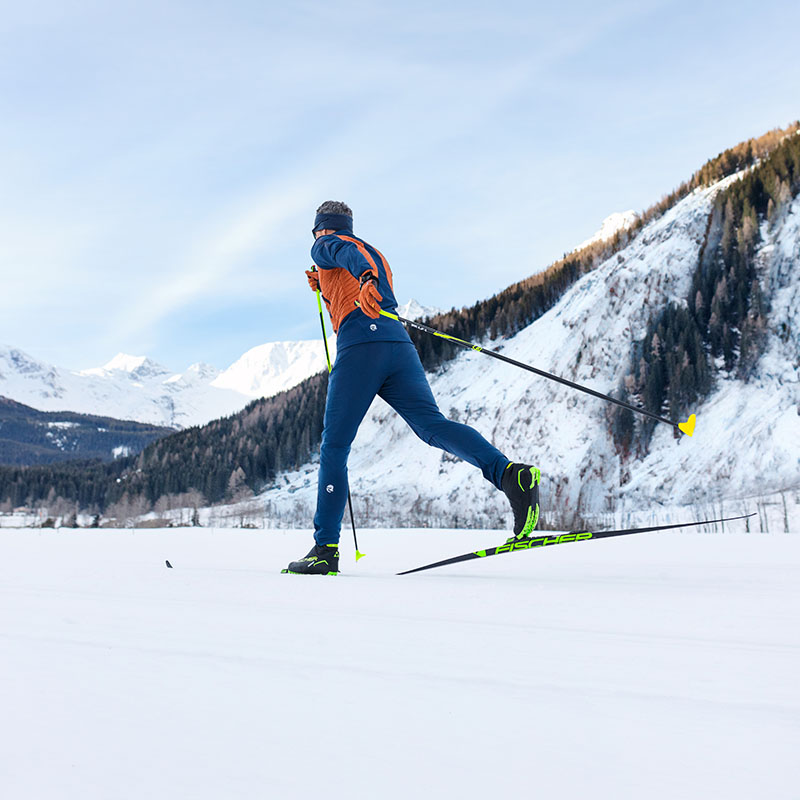
Winter Sports Equipment
Cross-Country Skiing
Cross-Country Skiing Gear: The extra push for the slope

Learning cross-country skiing is relatively easy: beginners usually start with the classic technique, which is similar to Nordic Walking in terms of arm and leg movements in the diagonal step. The classic technique is almost entirely used on specially prepared tracks. Other essential techniques in classic cross-country skiing are:
- Double poling or Parallel Stride is the most important technique in classic cross-country skiing. A parallel push-off with both arms while slightly bending your knees provides the energy for gliding. With this technique, amateurs can give their legs a short break when needed. The legs are not used for the kinetic impulse here and only stay inside the tracks. However, professional cross-country skiers achieve an additional push by rolling across the toes.
- The Herringbone is a climbing technique, which is used to increase friction on steep parts of the course when double poling does not help you in moving forward. The ski tips point outwards and the impulse comes from the inside edges of the skis. The ski sticks are next to the body or a bit behind the body and there is no gliding phase.

A bit more challenging than the classic technique is the skating technique (or simply skate skiing): you do not need prepared tracks here, because this technique is more dynamic in its motions. The loipe for skating is usually about three to five metres wide and icy. You will need a bit of practice and basic endurance to find the right timing for pushing-off and gliding, therefore, the skating technique usually is used by advanced cross-country skiers only. If you regularly go inline skating during the summers, you shouldn’t have too many problems with skis. In addition to the basic skating skills, you use the following techniques with cross-country skiing:
- With the one-stroke technique, each leg kick is supported by a double pole insert.
- With the asymmetrical leading arm technique, the pole is used every second leg kick, whereby the pole of the leading hand is guided close to the ski.
- In the arm swing technique, the simultaneous push-off with both arms only takes place every second step.
- In diagonal skating, which is mainly used by less experienced cross-country skiers to save energy on ascents, the movement sequence is similar to the bone step in classic cross-country skiing but, in contrast, has a small gliding phase.


The right equipment is crucial for cross-country skiing. It is best to seek expert advice in a winter sports shop. Skis form the basis, with classic and skating styles requiring different models. Bindings ensure a secure grip, while special cross-country boots provide optimum control and comfort. Ski poles provide stability and propulsion, and choosing the right clothing, including breathable clothing and matching accessories such as ski goggles, hats and gloves, is essential to stay warm and dry.
Compared to alpine skiing or snowboarding, the danger on the cross-country ski trail is relatively low, but there are still risk factors for cross-country skiing injuries. Icy trails or steep descents can lead to falls. However, inadequate training and, as a result, overloading and incorrect loading can also lead to painful consequences such as torn ligaments, inflammation or prolonged muscle tension (muscle dystonia).
The good news is that you can also proactively prevent such injury risks when cross-country skiing with the right equipment.
The Ski Socks from Bauerfeind Sports have been proven to increase your power through targeted compression. You benefit from a higher rapid and maximum power and improve blood circulation which prevents muscle and tissue damage - allowing you to stay on track for longer. The socks are made of a breathable, high-tech microfiber, which perfectly adapts to your body’s profile and has a temperature and moisture-regulating effect - which guarantees a high wearing comfort even during long tours.
Our ski socks are available in two versions:
- Ski Alpine Compression Socks (for maximum performance and comfort on long tours)
- Ski Touring Compression Socks (very comfortable and breathable)
Our Sports Recovery Socks are the ideal solution to promote your recovery after a strenuous cross-country skiing tour. Take a look at them now!!












